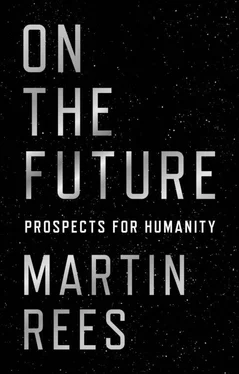The impediment to ‘decarbonising’ the global economy is that renewable energy is still expensive to generate. The faster these ‘clean’ technologies advance, the sooner their prices will fall so they will become affordable to developing countries, where more generating capacity will be needed, where the health of the poor is jeopardised by smoky stoves burning wood or dung, and where there would otherwise be pressure to build coal-fired power stations.
The Sun provides five thousand times more energy to the Earth’s surface than our total human demand for energy. It shines especially intensely on Asia and Africa where energy demand is predicted to rise fastest. Unlike fossil fuel, it produces no pollution, and no miners get killed. Unlike nuclear fission, it leaves no radioactive waste. Solar energy is already competitive for the thousands of villages in India and Africa that are off the grid. But on a larger scale it remains more expensive than fossil fuels and only becomes economically viable due to subsidies or feed-in tariffs. But eventually these subsidies have to stop.
If the Sun (or wind) is to become the primary source of our energy, there must be some way to store it, so there’s still a supply at night and on days when the wind doesn’t blow. There’s already a big investment in improving batteries and scaling them up. In late 2017 Elon Musk’s SolarCity company installed an array of lithium-ion batteries with 100 megawatts capacity at a location in south Australia. Other energy-storage possibilities include thermal storage, capacitors, compressed air, flywheels, molten salt, pumped hydro, and hydrogen.
The transition to electric cars has given an impetus to battery technology (the requirements for car batteries are more demanding than for those in households or ‘battery farms’, in terms of weight and recharging speed). We’ll need high-voltage direct current (HVDC) grids to transmit efficiently over large distances. In the long run these grids should be transcontinental—carrying solar energy from North Africa and Spain to the less sunny northern Europe, and east–west to smooth peak demand over different time zones in North America and Eurasia.
It would be hard to think of a more inspiring challenge for young engineers than devising clean energy systems for the world.
Other methods of power generation apart from the Sun and wind have geographical niches. Geothermal power is readily available in Iceland; wave power may be feasible but is of course as erratic as wind. Harnessing the energy in the tides seems attractive—they rise and fall predictably—but it is actually unpromising, except in a few places where the topography leads to an especially high tidal range. The west coast of Britain, with a tidal range of up to 15 metres, is one such place, and there have been feasibility studies of how turbines could extract energy from the fast tidally induced flows around some capes and promontories. A barrage placed across the wide estuary of the River Severn could yield as much power as several nuclear power stations. But this proposal remains controversial because of concerns about its ecological impact. An alternative scheme involves tidal lagoons, created by building embankments to close off areas of sea several miles across. The difference between the sea level inside and outside is used to drive turbines. These lagoons have the virtue that the capital cost is in low-tech and long-lived earthworks, which could be amortised over centuries.
Current projections suggest that it may be several decades before clean energy sources provide all our needs, especially in the developing world. If, for instance, solar energy and storage by hydrogen and batteries are inadequate (and these seem currently the best bets), then backup will still be needed in midcentury. Gas power would be acceptable if it were combined with carbon sequestration (carbon capture and storage, CCS) whereby the CO 2is extracted from the exhaust gases at the power station and then transported and permanently stored underground.
Some claim that it would be advantageous to actually cut the CO 2concentration back down to its preindustrial level—to sequester not just the future emission from power stations but also to ‘suck out’ what has been emitted in the past century. The case for this isn’t obvious. There’s nothing ‘optimal’ about the world’s twentieth-century climate—what’s damaging is that the anthropogenic rate of change has been faster than the natural changes in the past, and therefore not easy for us or the natural world to adjust to. But if this reduction were thought worthwhile, there are two ways of achieving it. One is direct extraction from the atmosphere; this is possible, but inefficient as CO 2is only 0.02 percent of the air. Another technique is to grow crops, which of course soak up CO 2from the atmosphere, use them as biofuels, and then capture (and bury) the CO 2that is re-emitted in the power station when they are burned. This is fine in principle but is problematic because of the amount of land needed to grow the fuel (which would otherwise be available for food—or conserved as natural forest), and because the permanent sequestering of the billions of tons of CO 2isn’t straightforward. A higher-tech variant would use ‘artificial leaves’ to incorporate CO 2directly into fuel.
What is the role of nuclear power? I myself would favour the United Kingdom and the United States having at least a replacement generation of power stations. But the hazards of a nuclear accident, even if improbable, cause anxiety; public and political opinion is volatile. After the Fukushima Daiichi disaster in 2011, antinuclear sentiment surged not only (unsurprisingly) in Japan but also in Germany. Moreover, one cannot feel comfortable about a worldwide programme of nuclear power unless internationally regulated fuel banks are established to provide enriched uranium and remove and store the waste—plus a strictly enforced safety code to guard against risks analogous to those from subprime airlines, and a firm nonproliferation agreement to prevent diversion of radioactive material towards weapon production.
Despite the ambivalence about widespread nuclear energy, it’s worthwhile to boost R&D into a variety of fourth-generation concepts, which could prove to be more flexible in size, and safer. The industry has been relatively dormant for the last twenty years, and current designs date back to the 1960s or earlier. In particular, it is worth studying the economics of standardised small modular reactors which could be built in substantial numbers and are small enough to be assembled in a factory before being transported to a final location. Moreover, some designs from the 1960s deserve reconsideration—in particular, the thorium-based reactor, which has the advantage that thorium is more abundant in the Earth’s crust than uranium, and also produces less hazardous waste.
Attempts to harness nuclear fusion—the process that powers the Sun—have been pursued ever since the 1950s, but the history encompasses receding horizons; commercial fusion power is still at least thirty years away. The challenge is to use magnetic forces to confine gas at a temperature of millions of degrees—as hot as the centre of the Sun—and to devise materials to contain the reactor that can survive prolonged irradiation. Despite its cost, the potential payoff from fusion is so great that it is worth continuing to develop experiments and prototypes. The largest such effort is the International Thermonuclear Experimental Reactor (ITER), in France. Similar projects, but on a smaller scale, are being pursued in Korea, the United Kingdom, and the United States. An alternative concept, whereby converging beams from immense lasers zap and implode tiny deuterium pellets, is being pursued at the Lawrence Livermore National Laboratory in the United States, but this National Ignition Facility is primarily a defence project that will provide lab-scale substitutes for H-bomb tests; the promise of controlled fusion power is a political fig leaf.
Читать дальше


![Мартин Рис - Всего шесть чисел. Главные силы, формирующие Вселенную [litres]](/books/414169/martin-ris-vsego-shest-chisel-glavnye-sily-formir-thumb.webp)









